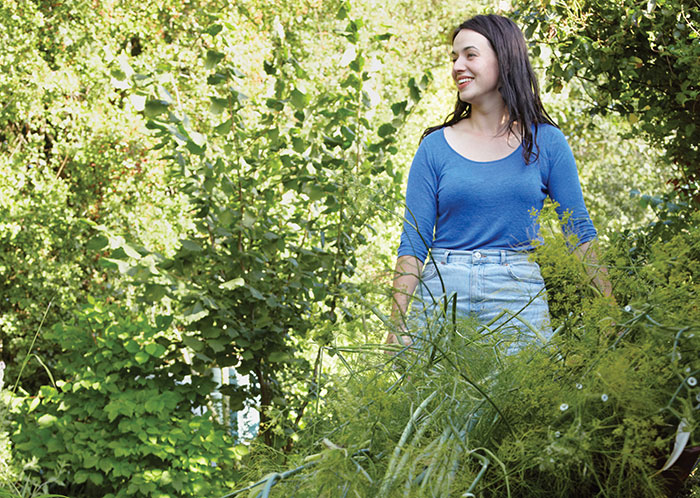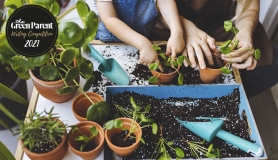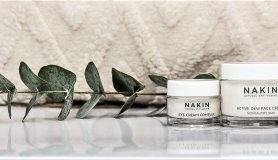Think about what produce you’d like to grow – this will probably be what you and your family like to eat. Remember that some crops demand a lot more attention and space than others, so be realistic about how much time you can devote to their care and concentrate on growing those crops that are really worth cultivating in your garden. To grow vegetables and fruit you need a sunny situation, ideally with a wall or fence nearby, to provide shelter, retain heat and, in some cases, reflect light. The soil needs to be deep, rich and well-drained. If it isn’t up to scratch, there are ways you can improve it, such as digging in organic matter. Alternatively, grow crops in raised beds or containers filled with multipurpose compost and place them in a sunny site.
“There is a move nowadays to make edible produce more visually interesting? By incorporating the crops into your flower borders”
It is true that in any garden the key is the soil the plants grow in, but with vegetable growing, a healthy soil becomes all the more important. To get it to a healthy state before you start, you can add all kinds of soil improvers and create deep beds of beautiful growing medium by digging down or building up and filling a large space with top-quality soil. You then have to keep your beds rich in nutrients to guarantee a high yield and high-quality crops. Regular watering, feeding, weeding and some form of mulch will keep your veg beds in peak condition during the growing season, and in between crops a large dose of manure or rich compost and ensuring you rotate your crops regularly (i.e. do not grow the same crop in the same bed year after year) will make your vegetables grow as well as they can.
The reason for rotating crops is fairly simple. Each plant uses nutrients in different quantities. Planting the same crop each season will mean that one area of land will be depleted of specific nutrients and others will be plentiful. Moving your crops around, specifically growing a different family of vegetables in a bed each year, prevents an imbalance of nutrients in the soil. Certain families of plants also replenish the nutrient supply, making them great to grow all over the garden and saving you money and time in buying and digging in manure. Legumes, for example, fix nitrogen in the soil.
Another important reason for rotating your crops is that certain crops are susceptible to specific diseases to which others are immune. Growing the same crop every year runs the risk of those diseases being able to really take hold in a bed. If you change the crop you can prevent a certain fungus or bacteria from becoming too strong, again preserving a more natural balance. There are some diseases that will stay in the soil for a long time, regardless of what is growing there. Club root, for example, is a disease that stunts the growth of members of the brassica family (that’s cabbage, kale, sprouts and turnips, amongst other things) and it will stay in the soil for around twenty years. If you keep planting a brassica in that soil, that will add another twenty years onto the life of the disease. The answer is to plant non-brassicas or, preferably, to dig out and replace all the affected soil before growing anything else to prevent the disease from spreading.
Obviously you cannot guarantee a disease-free vegetable patch by rotating your crops, but you can make it more likely that your plants will be as healthy as possible. The traditional way to grow vegetables is in straight lines, with wide soil paths between rows so you can walk through your crops to harvest, weed and feed plants easily. However, there is a move nowadays to make edible produce more visually interesting?by incorporating the crops into your flower borders.
Although it is slightly trickier to reach the plants this way, some gardeners argue that growing your fruit and vegetables in among ornamental plants keeps weeds and?pests at bay, as you will not be creating a monoculture. Problems can develop when you grow one type of crop on its own, because if a weed or pest or disease takes hold, it can spread quickly around the whole area and devastate the entire crop. Weeds out-compete plants that are more delicate, so planting something perennial or large (within reason) amongst a fragile crop can interrupt the spread of a weed.
A really good way of growing vegetables amongst other plants is to introduce?some companion planting. The idea of companion planting is that by growing different plants together you maximise the potential for pollination and therefore yield and simultaneously protect the crop from pests and diseases. Certain plants, such as marigolds and nasturtiums, are used in a vegetable patch as sacrificial plants – creatures like slugs and aphids will target them in preference to the more important crops. Some really good combinations are tomatoes and cabbage or cucumber and nasturtiums.
PUMPKINS AND SQUASHES
Not for the faint-hearted or those with a modestly sized plot. The foliage is large, the plant is large and the fruit is large! They are also some of the latest fruiting vegetables you can grow (unless you?grow the thinner-skinned, early fruiting squashes), which makes them a really valuable addition in terms of aesthetics in the autumn and the winter. The fruits of pumpkins are generally orange and round whereas squashes vary greatly, often a similar orange colour but also commonly green, yellow, golden, grey or blueish and even very ornate combinations of different colours. The shapes are similarly varied and can verge on the weird and wonderful. This makes them a fantastic vegetable to grow with children, who love seeing the rapid growth and impressive fruits. To plant pumpkins and squashes (and you can grow them together), simply sow the seeds in spring directly into the soil and leave at least 1m between each seed. Keep the plants well watered and fed and once?they start producing fruit – especially?if that fruit becomes very large – turn it periodically so that it grows into a nice, even shape, otherwise they tend to become flat on one side. Harvest from late summer, right through the autumn and store?them in a cool, dry place for months after harvesting.
KALE AND CABBAGE
These are members of the brassica family, which are long lived, healthy and grow throughout the season. You can buy small plants or grow them from seed and apart from thinning, regular harvesting and pinching out to avoid bolting they require very little maintenance. Members of the brassica family are susceptible to a disease called club root, which severely inhibits growth of the roots and will result in an extremely poor yield. The spores stay present in the soil for a long time so be sure to remove any affected soil and preferably avoid growing brassica in that spot for a good few years after the infection. There are two other banes of the brassica grower’s life. These are slugs and another little pest called cabbage white caterpillars. The slugs can be dealt with using the usual methods or barriers, beer traps and deterrents such as eggshells, hair or wool, chilli powder or salt. The caterpillars take a little more dealing with and they will munch through a cabbage leaf in no time at all. They are the larvae of the cabbage white butterfly and the best way to keep them at bay is by netting the plants.
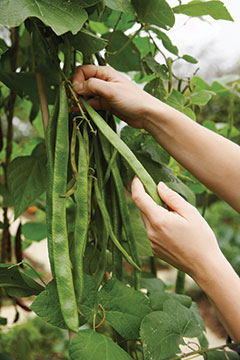
CLIMBING FRENCH? AND RUNNER BEANS
I would grow a crop of beans each year as part of your rotation. They’re a pleasure to grow and taste delicious. They don’t take up much room and their flowers are ornamental, so they’re good for gardens where space is at a premium. Sow the seed in a pot containing seed compost covered by a few centimetres of the same compost and keep it watered until the seedling pokes its first shoot above the soil. Once it’s growing and all risk of frost is over, plant it into the garden next to a cane. As the plant grows it will wind its way around the cane. If you water regularly, you’ll find the cheerful red flowers give way to plump pods full of peas and pulses. I just love wandering among my rows of beans on a hazy summer afternoon, picking and eating them, still warm from the sun. At the end of the year, either pull out the plants or cut them off at ground level. Like all legumes, the roots will have fed your soil with nitrogen, ready to benefit the next crop to be planted there.
LETTUCE
Lettuce is a great vegetable because?with a regular sowing of seeds into cells of seeds and cutting compost, you can create a succession of lettuce that will last throughout the summer. Plant out the seedlings once they have a few sets of leaves and water them well. You will need to keep them watered whilst they grow?so ideally the beds should be constantly moist though not too wet. There are many varieties of lettuce, which are divided into those with a loose formation of leaves, those that are more densely packed, forming a solid heart, and the ones in between. The classic ‘Iceberg’ or ‘Little Gem’ (a small lettuce) are heart- forming varieties; non-heart forming varieties are equally tasty but just have fewer leaves. A popular example is ‘Lollo Rosso’ which has curly, red leaves. Do protect your lettuces from slugs by putting some sort of barrier such as wool, hair, eggshells, chilli powder or copper around the plants to keep these pests away.
PROVIDING NUTRIENTS FOR CROPS
Crop plants are a lot more work intensive for the gardener than ornamental plants, so you can’t expect to just leave them alone and reap the benefits year after year. The key thing you need to provide is nutrients. Although flowers and trees do benefit from nutrients, usually there are enough of them in the soil to keep them afloat. With fruit and vegetables, which are much hungrier, it is an entirely different story.
IMPROVE YOUR SOIL
When preparing the soil before planting, you should add nutrient-rich organic matter, such as well-rotted manure or compost and slow-release fertilisers. As their name suggests, the latter break down slowly in the soil (over weeks or sometimes months) so the growing plants can make use of them as needed. Other forms of fertiliser are wood fire ash and green manure.
SLOW-RELEASE FERTILISERS
Poultry manure, blood, fish and bone, bonemeal and seaweed are all organic slow-release fertilisers that you can buy in pellet, powder or granular form. Select the types that are appropriate to the crops you’re growing, bearing in mind the proportions of the three main plant nutrients: nitrogen (N), for leaf and stem growth; phosphates (P), for root growth; and potassium (K), for flower and fruit development. Sprinkle them onto the soil and water them in, or put a little in the soil as you plant. Don’t use more than the guidelines on the packets advise, and for best results mix them well with soil first. If in doubt, use less than you think as over-fertilising can cause as many problems as it solves. And besides, you can always go back and feed the border again if you didn’t put enough feed down the first time.
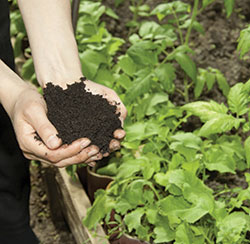
MAKE YOUR OWN COMFREY FERTILIZER
You can make your own organic liquid fertiliser from comfrey, which makes an excellent feed as it provides a good source of nitrogen and potassium. Pick the leaves, put them into a fine-mesh sack, which you immerse into water, and leave them to soak for a month or so, stirring occasionally in between. The ‘tea’ is ready when it turns dark brown, a little sludgy and starts to produce what can only be described as the most hideous smell known to man. Dilute it to look like weak tea and apply it with a watering can. Comfrey tea also helps to activate a compost heap, so pour a little bit of it on to the surface.
WOOD FIRE ASH
Burning any wooden material that has not been tanalised or treated with creosote produces an ash that is very rich in potassium. Sprinkle the ash onto the soil in winter, before planting or around the base of existing plants, and it will help the crops develop flowers and fruit.
GREEN MANURE
There are certain plants that will do wonders for your soil. Known as ‘green manure’, these are fast-growing crops (e.g. red clover, peas, beans and mustard) that are raised on empty beds (usually over winter) and then dug into the soil with their roots at least four weeks before planting your crops. They add nitrogen to the soil, increase the humus content, improve the soil structure and act as a weed suppressant.
FOODS FOR CROPPING PLANTS
Once the plants are growing, you need to give them a boost with liquid or soluble feeds. These get washed through the soil fairly speedily, but you will see a difference to the plant within a matter of minutes sometimes.?There are a number of options for feeds, both organic and chemical (inorganic). Although it’s good to try to be organic where we can, there are some advantages to chemical fertilisers. They give you greater control about when and how the plant can benefit from their effects, they tend to be more balanced, and provided you follow the instructions you can avoid the problem of over-feeding. Those that are available in liquid or soluble form include tomato feed (which can be used for any flowering or fruiting plant), seaweed extract and general-purpose feed.
Frances is the author of First-Time Gardener: How to plan, plant & enjoy your garden (£20 Kyle Books)

